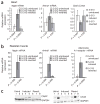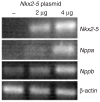RNA toxicity in myotonic muscular dystrophy induces NKX2-5 expression
- PMID: 18084293
- PMCID: PMC2909759
- DOI: 10.1038/ng.2007.28
RNA toxicity in myotonic muscular dystrophy induces NKX2-5 expression
Abstract
Myotonic muscular dystrophy (DM1) is the most common inherited neuromuscular disorder in adults and is considered the first example of a disease caused by RNA toxicity. Using a reversible transgenic mouse model of RNA toxicity in DM1, we provide evidence that DM1 is associated with induced NKX2-5 expression. Transgene expression resulted in cardiac conduction defects, increased expression of the cardiac-specific transcription factor NKX2-5 and profound disturbances in connexin 40 and connexin 43. Notably, overexpression of the DMPK 3' UTR mRNA in mouse skeletal muscle also induced transcriptional activation of Nkx2-5 and its targets. In human muscles, these changes were specific to DM1 and were not present in other muscular dystrophies. The effects on NKX2-5 and its downstream targets were reversed by silencing toxic RNA expression. Furthermore, using Nkx2-5+/- mice, we show that NKX2-5 is the first genetic modifier of DM1-associated RNA toxicity in the heart.
Conflict of interest statement
The authors declare competing financial interests: details accompany the full-text HTML version of the paper at
Figures








Similar articles
-
NKX2-5, a modifier of skeletal muscle pathology due to RNA toxicity.Hum Mol Genet. 2015 Jan 1;24(1):251-64. doi: 10.1093/hmg/ddu443. Epub 2014 Aug 28. Hum Mol Genet. 2015. PMID: 25168381 Free PMC article.
-
Age of onset of RNA toxicity influences phenotypic severity: evidence from an inducible mouse model of myotonic dystrophy (DM1).PLoS One. 2013 Sep 5;8(9):e72907. doi: 10.1371/journal.pone.0072907. eCollection 2013. PLoS One. 2013. PMID: 24039817 Free PMC article.
-
Reversible model of RNA toxicity and cardiac conduction defects in myotonic dystrophy.Nat Genet. 2006 Sep;38(9):1066-70. doi: 10.1038/ng1857. Epub 2006 Jul 30. Nat Genet. 2006. PMID: 16878132 Free PMC article.
-
Myotonic dystrophy--a multigene disorder.Brain Res Bull. 2001 Oct-Nov 1;56(3-4):389-95. doi: 10.1016/s0361-9230(01)00656-6. Brain Res Bull. 2001. PMID: 11719277 Review.
-
Myotonic dystrophy: molecular windows on a complex etiology.Nucleic Acids Res. 1998 Mar 15;26(6):1363-8. doi: 10.1093/nar/26.6.1363. Nucleic Acids Res. 1998. PMID: 9490778 Free PMC article. Review.
Cited by
-
Systemic therapy in an RNA toxicity mouse model with an antisense oligonucleotide therapy targeting a non-CUG sequence within the DMPK 3'UTR RNA.Hum Mol Genet. 2020 Jun 3;29(9):1440-1453. doi: 10.1093/hmg/ddaa060. Hum Mol Genet. 2020. PMID: 32242217 Free PMC article.
-
Epigenetic mechanisms in heart failure pathogenesis.Circ Heart Fail. 2014 Sep;7(5):850-863. doi: 10.1161/CIRCHEARTFAILURE.114.001193. Circ Heart Fail. 2014. PMID: 25228320 Free PMC article. Review. No abstract available.
-
Antisense oligonucleotides: the next frontier for treatment of neurological disorders.Nat Rev Neurol. 2018 Jan;14(1):9-21. doi: 10.1038/nrneurol.2017.148. Epub 2017 Dec 1. Nat Rev Neurol. 2018. PMID: 29192260 Review.
-
Disease Phenotypes in a Mouse Model of RNA Toxicity Are Independent of Protein Kinase Cα and Protein Kinase Cβ.PLoS One. 2016 Sep 22;11(9):e0163325. doi: 10.1371/journal.pone.0163325. eCollection 2016. PLoS One. 2016. PMID: 27657532 Free PMC article.
-
Myotonic dystrophy: is a narrow focus obscuring the rest of the field?Curr Opin Neurol. 2012 Oct;25(5):609-13. doi: 10.1097/WCO.0b013e328357b0d9. Curr Opin Neurol. 2012. PMID: 22892953 Free PMC article. Review.
References
-
- Harper PS. Myotonic Dystrophy. W.B. Saunders; London: 1989.
-
- Mahadevan M, et al. Myotonic dystrophy mutation: an unstable CTG repeat in the 3′ untranslated region of the gene. Science. 1992;255:1253–1255. - PubMed
-
- Tapscott SJ, Thornton CA. Biomedicine. Reconstructing myotonic dystrophy. Science. 2001;293:816–817. - PubMed
-
- Mankodi A, et al. Myotonic dystrophy in transgenic mice expressing an expanded CUG repeat. Science. 2000;289:1769–1773. - PubMed
Publication types
MeSH terms
Substances
Grants and funding
LinkOut - more resources
Full Text Sources
Other Literature Sources
Medical
Molecular Biology Databases

